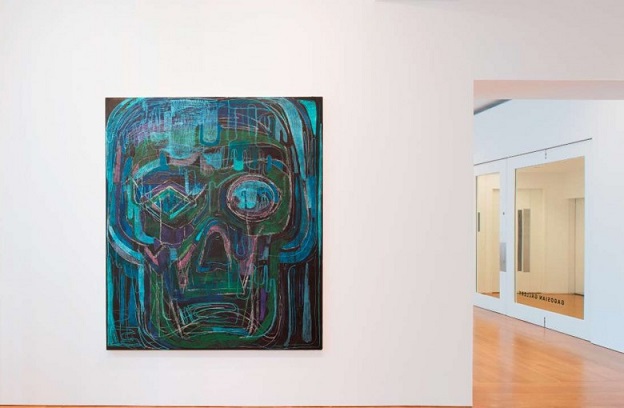藝評
Thomas Houseago: Psychedelic Brothers – Drawn Paintings
約翰百德 (John BATTEN)
at 12:13pm on 18th July 2016

Caption:
Thomas Houseago: Psychedelic Brother III (blue architecture), pastel, crayon, pencils, oil and acrylic on canvas, 2016. Image courtesy: South China Morning Post, Gagosian Gallery.
(原文以英文發表,評論高古軒畫廊的托馬斯‧豪斯雅戈「Psychedelic Brothers – Drawn Paintings」展覽。)
The paintings of Yorkshire-born, Los Angeles-based artist Thomas Houseago (pronounced howz-ago) glide through a blend of 20th century Futurism, Cubism and modernism. These are accomplished and informative studies accurately described in the exhibition title as ‘drawn paintings.’ Despite a carefully unfinished quality to each of the nine large exhibited paintings, these are not rapid-fire drawings or sketches, but - particularly in the complex Psychedelic Brother III (blue architecture) - fully resolved work with elaborate layers of pastel, crayon, pencils, oil and acrylic on canvas.
Hauseago is a figurative sculptor who studied a foundation art course in Leeds, at St Martins School of Art in London and at De Ateliers in Amsterdam; he lived in Brussels before relocating to Los Angeles in 2003. His sculpture is generally large, and completed with a team of assistants working in a large warehouse in Los Angeles and, for his bronze pieces, cast in foundries around the USA. Sought after by collectors, his L’homme pressé, a huge bronze sculpture of a hurriedly striding figure was prominently displayed at the 2011 Venice Biennale, installed directly on the Grand Canal outside French collector and Christies’ owner François Pinault’s Venice palazzo-museum as part of his collection.
Knowledge of Hauseago’s sculpture, rarely previously seen in Hong Kong, gives better understanding of this exhibition. Hauseago draws inspiration from the long history of sculpture, beginning with Greek and classical human forms, and later, stripped-down, simplified interpretations of the human figure and architecture by Cubism and minimal modernism. Equally influential are his sculptural elders: Henry Moore, Jacob Epstein and Eduardo Paolozzi, alongside elements of popular culture, including cartoon characters such as The Flintstones, Japanese anime and science fiction, often in the form of the familiar profile of Star Wars’ Darth Vader.
However, it the ‘primitivism’ of African and Oceanic art that is most clearly seen in his sculpture and these paintings. Hauseago’s favourite indoor sculpture-forming material is Tuf-Cal, an extra toughened plaster, which he lets dry rough, white and bare. Often, Hauseago’s distinctive figures use a mask as a stylised face sitting atop exposed plywood or the sculpture’s underbelly, its metal armature. These drawn paintings have a similar mask-like quality. The beginnings of these two-dimensional renderings of the mask can be seen in an earlier sculpture, Mask (black hill/red hill) of 2009. In this work, Houseago prepares a raw, flat outline of a face in Tuf-Cal, but instead of working the plaster, he completely draws over the surface to depict deep eye sockets, one clear eye and an open almost-smiling mouth with darkly black hair covering one side of the face.
The basic mask motif of these paintings was settled years earlier, but the use of crayons and pastels was only recently realised when Hauseago was drawing with his young daughter. These paintings are the first the artist has ever publicly exhibited and each uses the mask, skull-like, as the basis of a universal, egalitarian, homogenous full-faced portrait. They all appear anonymous, but each is personal. The Drawn Painting – Fathers Ghost I (astronaut) is a highly worked and layered portrait of the artist’s father who was diagnosed with schizophrenia when Hauseago was a young boy. The painting’s vigorous swirls of lines intimate an anguished man, and in its execution an artist reflecting on himself as a distressed child.
In each painting, the “psychedelic” linking of minds between family and friends – indeed, all of us - is intensified by repetitive and obsessive lines across the canvas and shafts of colour in a narrow palette range, often in shades of purples and blues. The primitivism of these paintings is reminiscent of Outsider Art: naïve, self-conscious, and honest, but with a wholeness of form that equally has a child-like quality and an uncanny maturity and insight into the fragility of human nature and of life.
In common, each of the nine portraits depicts an aspect of the mask as skull. The skull is a memento mori (Latin: “remember you must die”), a classical and artistic symbol reminding us that life is tempered by death and we should be humble in our lives. It is always a sobering message, and within a range of other emotions makes this exhibition more powerful than just any painted portrait show.
Link for further information:
'Thomas Houseago' @ Gagosian Gallery
A version of this review was published in the South China Morning Post on 10 July 2016.
